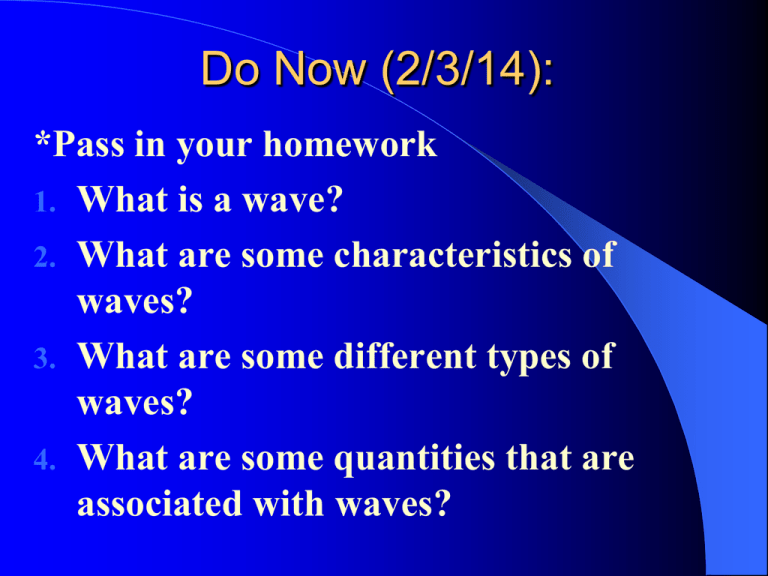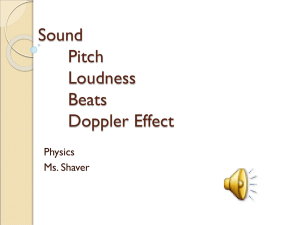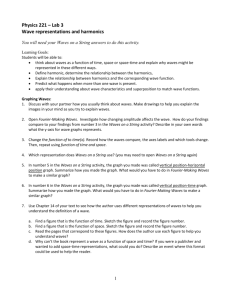WaveProperties Timson
advertisement

Do Now (2/3/14): *Pass in your homework 1. What is a wave? 2. What are some characteristics of waves? 3. What are some different types of waves? 4. What are some quantities that are associated with waves? Objectives Discuss the origin and significance of beats. Solve problems using propagation speed, frequency, and wavelength. Use the superposition principle and determine the resultant wave when two waves merge. Understand the principles of reflection, refraction, dispersion, and diffraction as they relate to mechanical waves. Wave basics Transverse vs longitudinal Standing wave Period Frequency Amplitude Intensity v=f Node, antinode Standing Waves Standing waves are produced when waves traveling in opposite directions overlap – When they overlap they add to each other – Positive parts of the waves get bigger; negative parts subtract Interference Waves will interact in space. Constructive and destructive interference. Depends upon the phase relationship between the waves. Video… Waves Add When They Overlap Another simulation Natural Frequencies When any object composed of elastic materials is disturbed, it vibrates at its own set of frequencies. – We call these an object’s natural frequencies. Natural frequency The frequency that requires the minimum energy to produce forced vibrations. This is also the frequency that requires the least amount of energy to continue this vibration. The natural frequency depends on the elasticity and shape of the object. Resonance Natural frequency of vibration. Forced vibration near or equal to natural frequency results in high amplitude. Significance to solid objects. Tuning Forks Singing wine glass Water in a tube. Tacoma Narrows in 1940. Problem A sound wave in air has a frequency of 262 Hz and travels with a speed of 330m/s. How far apart are the wave crests (compressions)? Sound is a longitudinal wave Sound can also be called a pressure wave Humans hear 20-20,000 hz Pitch vs frequency Speed of sound is 331m/s @ 0°C. Add .6m/s for every additional degree. When Sounds Are Close in Frequency We Hear Beats Beat frequency : f1 f 2 Practice How many beats per minute are heard when two strings of a guitar are played, where the D string has a frequency of 330 Hz and the B string has a frequency of 247 Hz? Intensity and Amplitude Loudness is the impression of sound intensity. Intensity is the energy transported by a wave per unit of time across unit area. Decibel combines “loudness” and intensity using logarithmic scale. (in dB) = 10log(I/I0) I is proportional to 1/r2 Doppler Effect Occurs with all waves when either the source and/or the observer are moving relative to the other. http://www.surendranath.org/applets/waves/ doppler/dopplerapplet.html http://www.kettering.edu/~drussell/Demos/ doppler/doppler.html The Doppler Effect Equation: (o=observer, s =source v vo f ' f v v s What would the equation be for a stationary observer? Do Now (2/4/14): A tuning fork produces a steady 400Hz tone. When it is struck and held near a vibrating guitar string, twenty beats are counted in five seconds. What are the possible frequencies produced by the guitar string? Doppler Effect – Stationary Observer Doppler Frequencies Doppler Effect Practice Two automobiles are equipped with the same single-frequency horn. When one is at rest and the other is moving toward an observer at 15m/s, a beat frequency of 5.5 Hz is heard. What is the frequency the horns emit? Assume 20°C. Practice: Work with your group to complete the multiple choice questions in chapter 14. This will be collected! Do not forget to justify each of your answers!!!! More sound info Air columns – Open column L=1/2λ – Closed column L=1/4λ Calculating Harmonics Slinky LAB Do Now (2/5/14): A train moving at a speed of 40 m/s sounds its whistle, which has a frequency of 500 HZ. Determine the frequency heard by a stationary observer as the train approaches the observer. (use 345 m/s for the speed of sound) A cylindrical air column with both ends open will vibrate with a fundamental mode such that the air column length is one half the wavelength of the sound wave. Each end of the column must be an antinode for the air Open Pipe Harmonics Air Particles: Closed Pipe Harmonics A closed cylindrical air column will produce resonant standing waves at a fundamental frequency and at odd harmonics. The closed end is constrained to be a node of the wave and the open end is an antinode. In the fundamental mode the wavelength is four times the length of the air column. The closed end prevents the column from producing the even harmonics. Closed Pipe Harmonics Practice: A pipe is 2.46 m long. Determine the frequencies of the first three harmonics if the pipe is open at both ends. Take 345 m/s as the speed of sound in air. Harmonic practice What will be the fundamental frequency and first 2 harmonics for a 40cm long organ pipe at 20° C if it is open? What about if it is closed? Practice A pipe in air at 20°C is to be designed to produce two successive harmonics at 240Hz and 280Hz. How long must the pipe be, and is it open or closed? Misc Sound notes Reflection Refraction Dispersion Diffraction Reflection - Waves Will Reflect When They “Bounce” Off of an Object What do you notice about the reflected wave compared with the starting wave? Refraction: The Bending of Wavefronts The wave front bends because of a difference in the velocity of the wave due to material change. Waves Also Spread Out (Diffract) When They Go Through Openings or Around Objects Do Now (2/6/14): What will be the fundamental frequency and first 2 harmonics for a 40cm long organ pipe at 20° C if it is open? What about if it is closed? Practice: Complete the Refraction Worksheet *Bonus: complete as many multiple choice problems from chapters 14 and 20 as you can – do not forget to justify your answers!!! Or you may work on your homework Do Now (2/7/14): After passing from one material into another, a light ray makes an angle of refraction of 11.63º. If it came from a medium with index of refraction 1.74 and passed into a medium with index of refraction 1.35, what angle of incidence did the ray make when it was in the first medium? Investigate You have three things to work on. Take turns: 1. tuning fork investigation 2. Waves at Boundaries Investigation 3. AP Problem (part ii is tricky! Don’t worry about it if you can’t solve) Videos http://www.acs.psu.edu/drussell/Demos/refl ect/reflect.html http://www.animations.physics.unsw.edu.au /jw/waves_superposition_reflection.htm Electromagnetic Spectrum Who is Maxwell and what are his equations? Electromagnetic Waves Accelerating electrical charges produce magnetic fields that produce electric fields etc. http://micro.magnet.fsu.edu/primer/java/wavebasi cs/index.html Propagate away from source in form of transverse wave. Energy that can travel through space. 3.0 x 108 m/s Electromagnetic Spectrum Classifies e-m energy according to frequency. All travel at same speed in vacuum. c=f http://micro.magnet.fsu.edu/primer/java/wa vebasics/index.html Electromagnetic Spectrum








